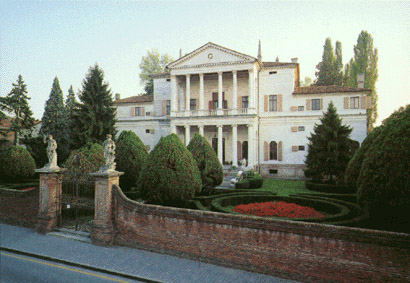Architectural
features
Villa
Cornaro, located in the village of Piombino Dese about 30km from Venice,
is a masterwork of Palladio's middle period. One prominent magazine has included the Villa in a list of 10 of the world's most important buildings
("Top Ten Buildings," Town & Country). Others have cited it as "possibly Andrea Palladio's most influential work" (Mitrovic and Wassell).
Constructed
in 1552-3 for Giorgio Cornaro, younger son of a wealthy Venetian family,
Villa Cornaro introduced to Western architecture the two-story projecting
portico-loggia motif. Palladio's device influenced Western architecture
for hundreds of years, becoming a recurrent feature in Georgian, Adam
and Colonial American architecture.
The
impact of the motif can be ascribed to two primary factors. First, it
anticipated the change in the concept of residences, away from the fortress
and toward comfort, function, and interaction with surroundings. Second,
the double portico-loggia motif was striking, flexible and subject to
infinite elaboration and permutation by subsequent generations of architects.
Among those utilizing the device was Thomas Jefferson, who selected
Villa Cornaro as his initial model for Monticello.
Equally
important, however, is the exquisite harmony of the Villa's interior
spaces. The living area of the Villa's central core forms a square within
which are arranged six repetitions of an elegant standard module.
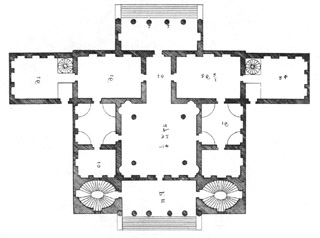
The
module, exemplified by the two rooms to the left and right of the entrance
hall, is 16 Trevisan feet in width by 27 Trevisan feet in length, creating
a ratio of 6 to 10, the "perfect" numbers of Renaissance architecture.
The sum of those numbers was deemed "most perfect" and, as indicated,
was used by Palladio as the width of the module. Palladio repeated the
module on the east and west sides of the Villa, where the module is
divided into a square room of 16 x 16 feet and a smaller room beyond.
The central grand salon comprises two of the modules placed side by
side. The 9-room floor plan of the piano nobile is exactly repeated
in a second piano nobile above, with four mezzanine rooms between.
The Villa
is unique among extant Palladian works for the extent of its original
tile and terrazzo floors and original exterior intonaco (the stucco-like
material covering the brick substructure of Palladio's country villas).
The south facade bears surviving graffiti recording Cornaro family births in the
1600s, numerous family deaths and honors, and a note from a cousin recording
his 1690 flight to Piombino from Venice to avoid "contagion."
Statuary
Gallery
In 1588 the son of the Villa's original patron commissioned the six
statues by Camillo Mariani that decorate the grand salon.
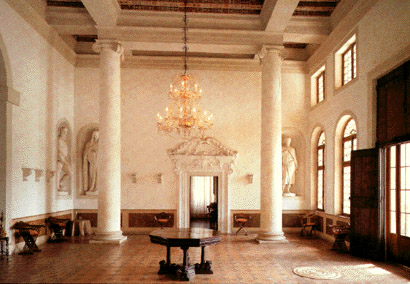
The statues, which fill
niches that were part of Palladio's original design, represent an innovation
in Renaissance sculpture: a private family portrait gallery with full-figure
statues of prominent members instead of mere busts. The family pantheon
includes Doge Marco Cornaro and Caterina Cornaro, Queen of Cyprus.
Fresco
Cycle
The walls of Villa Cornaro
remained in white for many years to accommodate the magnificent painting
collection of the early owners. In 1716 Andrea Cornaro, the great great
grandson of Giorgio Cornaro, launched a new decorative program. He commissioned
Mattia Bortoloni, a young student of Antonio Balestra, to execute a
large cycle of 104 fresco panels within a system of stucco putti and
frames created by Bortolo Cabianca of Venice.
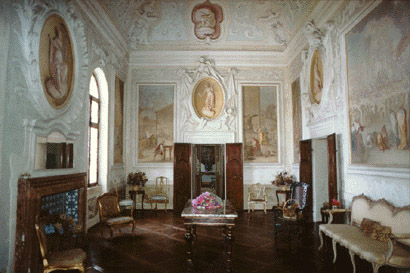
The frescos in six rooms
of the piano nobile feature scenes from the Old Testament; in two rooms
of the second floor the frescos depict New Testament scenes. The Biblical
theme and the specific subjects of the individual frescos were designated
by Andrea Cornaro himself. Bortoloni, then 21 years old, utilized the
newly evolving "light manner," one of the first extensive fresco demonstrations
of that style in the Veneto.
The subjects of the
frescos appear to have been selected to portray themes of freemasonry,
a conclusion strengthened by the apparent use of Masonic symbols in
the frescos on the eastern walls of the principal frescoed rooms. Thus
the frescos may be one of the earliest examples of Masonic art in Italy. (See Gable, Villa Cornaro in the Enlightenment: Adapting a Palladian Villa to Eighteenth-Century Ideals (Boglewood, 2013).
Renewal
|
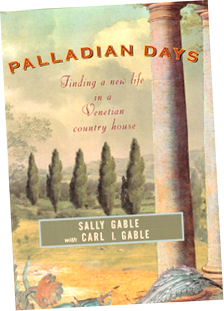
|
Villa
Cornaro remained in the Cornaro family for 253 years, then passed
through three other families as a private residence until 1951.
After a difficult period
in the 1950s and 60s when it was used as a parochial kindergarten
and then stood vacant, Villa Cornaro returned to private ownership
in 1969 and was restored over a period of 20 years by an American couple from Greenwich, Connecticut USA.
From 1989 to 2017 Villa
Cornaro was the spring and autumn residence of Mr. and Mrs.
Carl I. Gable of Atlanta, Georgia, USA, whose experiences are recounted in Palladian Days: Finding a New Life in a Venetian Country House (Knopf, 2005).
The Villa is now owned by the seventh family in its more than 470-year history. |
Tourist
Information
Location:
Piombino Dese (Padua District). Accessible by car or train.
Piombino Dese
is 30km northwest of Venice (about 40 minutes by car or train). The
villa is two blocks from the Piombino Dese train station.
Hours:
Open to groups by appointment
(Email mioriky@gmail.com; telephone 049/936-5017)
